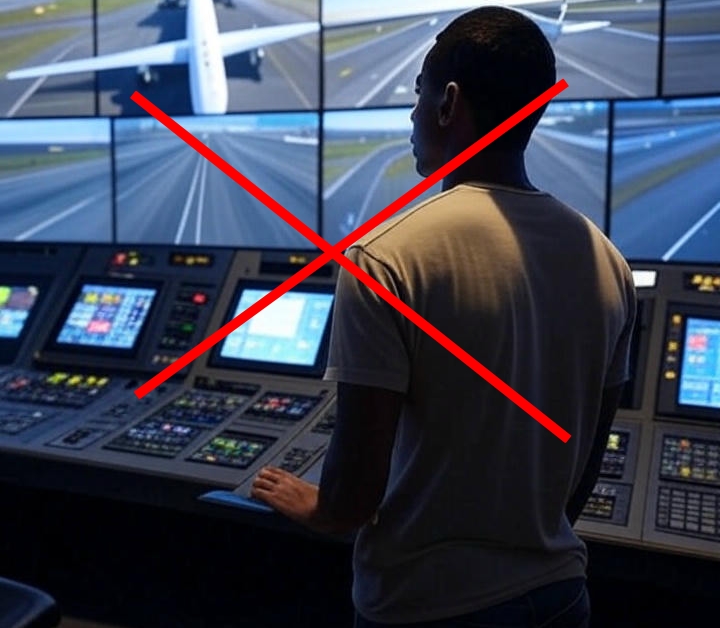The Guilde Luxembourgeoise des Contrôleurs de la Circulation Aérienne (GLCCA) has been closely monitoring the evolution of remote tower technology in recent years. In doing so, we
have actively engaged with industry developments, followed IFATCA and EASA guidelines, and collaborated with European counterparts to evaluate its suitability for Luxembourg Airport
(ELLX). With extensive experience in implementing both simple and complex air traffic control systems, we offer critical insights into the challenges of adopting new technologies.
This study reflects a comprehensive analysis, conducted in alignment with international
standards and best practices.
While innovative solutions hold potential to enhance safety and operational efficiency, remote tower systems remain in an early developmental stage. For high-traffic, airports like ELLX,
findings indicate that current limitations significantly outweigh proposed benefits. This paper outlines critical concerns related to safety constraints, operational incompatibilities, increased
maintenance demands, and unproven economic advantages.
Safety Limitations
1. Compromised Situational Awareness and Responsiveness:
Virtual towers rely on camera feeds, lacking direct visual and auditory cues (e.g., engine sounds, windshifts) and introducing delays (milliseconds to over a second). This impairs controllers’ ability to monitor dynamic operations and respond promptly to runway incursions or emergencies, significantly increasing collision risks at high-traffic airports like ELLX.
2. System Vulnerabilities: Failures in cameras, networks, or power supplies can result in frozen or blank screens, halting operations without a fallback, unlike conventional towers that allow continued observation. This poses substantial risks during peak traffic or emergencies.
3. Cybersecurity Threats: Network-dependent virtual towers are susceptible to cyberattacks (e.g., data tampering, denial-of-service), which could mislead controllers and compromise safety. As Luxembourg’s sole NATO airport, a successful attack could disrupt national and military operations, leaving the country without an operational airport.
4. Susceptibility to Simple Disruptions: Even something as simple as a handheld laser pointer aimed at a camera, which are typically mounted on high masts and visible from long distances, could render the lens temporarily useless, blinding controllers at critical moments. Such easily executed attacks may severely impair situational awareness during key phases of flight operations.
5. Weather-Related Limitations: Adverse weather (e.g., heavy rain, snow, glare, sudden storms, lightning) degrades camera performance and may disable feeds, compromising visibility of aircraft, vehicles, or obstacles. Conventional towers, resilient in such conditions, ensure safer operational continuity.
6. Inadequate Detection of Hazards: Limited camera resolution and blind spots hinder detection of small foreign objects, wildlife (e.g., birds during migration), or crashes outside monitored areas, delaying responses and increasing risks of runway hazards or bird strikes.
7. Controller Fatigue: Prolonged screen use, system lag, and managing multiple camera views increase cognitive strain, elevating the risk of errors or burnout, particularly during complex operations at busy airports.
8. Potential Over-Reliance on Advanced Features: Dependency on advanced systems (e.g., radar or visual tracking) for situational awareness may leave controllers unprepared if these systems fail, especially without robust fallback procedures, compromising safety.
Operational Incompatibilities
1. Unsuitability for Complex Airports: Virtual towers are designed for low-traffic, simple airports and are inadequate for ELLX’s complex environment, characterized by a 4 km runway, 100,000 annual movements, and diverse operational demands.
2. Challenges with Mixed and VFR Traffic: Virtual towers struggle to manage diverse aircraft (e.g., student pilots, general aviation, helicopters, large jets) and Visual Flight Rules (VFR) operations, including frequent military flights at ELLX, due to limited visual fidelity and delays. This risks inadequate separation, delays, and disruption of flight school and military operations.
3. Inefficiencies in High-Traffic Operations: High movement volumes and visual separation constraints for VFR operations reduce traffic throughput, necessitating wider aircraft spacing and causing delays, undermining ELLX’s capacity and efficiency.
4. Ground Operation Challenges: Camera blind spots and delays hinder precise coordination of runway crossings and vehicle management on the runway or taxiways, increasing the risk of undetected incursions and safety incidents in busy ground operations.
5. Unplanned Flights and Training Traffic: Unexpected or emergency aircraft and unpredictable flights require real-time judgment, which virtual systems struggle to support, risking delayed responses and disruptions to critical operations.
6. Helicopter Operations: VFR helicopter operations (e.g., Police, Air Rescue) landing on active taxiways demand real-time precision, which virtual towers cannot provide, rendering such operations unmanageable.
7. Limited Validation for Complex Scenarios: SESAR validations primarily focus on low- to medium-density airports with simpler layouts, offering limited evidence for virtual towers’ feasibility at complex, high-traffic airports like ELLX, increasing operational uncertainty.
Increased Maintenance Demands
1. Continuous Technical Support Requirements: Virtual towers require 24/7 operation of cameras, networks, and power systems, necessitating dedicated teams with expertise in IT, cybersecurity, systems engineering, and surveillance technologies. This significantly increases staffing needs and operational complexity compared to conventional towers.
2. Difficulty in Securing Qualified IT Personnel: The persistent shortage of specialized IT staff, as evidenced by Skyguide’s Virtual Center program delays (ongoing as of May 2025), poses challenges in maintaining system reliability, risking operational disruptions.
3. Ongoing Equipment Upkeep: Cameras require regular cleaning, calibration, and replacements to mitigate environmental impacts (e.g., weather, bird droppings), adding logistical challenges and potential downtime.
4. Power Reliability Needs: Uninterrupted primary and secondary power supplies are critical, requiring costly infrastructure and maintenance, particularly in regions prone to weather disruptions.
5. Complex Technical Architecture: Integrating visual surveillance and data networks demands robust redundancy and maintenance to prevent single points of failure, increasing complexity and cost.
6. Camera Placement Constraints: Cameras in runway safety areas must be frangible and comply with strict regulations, adding installation and maintenance complexity.
For example, the 46-meter camera mast at Liège Airport, and already delayed by more than 2 years, illustrates the significant infrastructure and regulatory challenges.
Unproven Economic Benefits
1. High Initial and Ongoing Costs: Deploying high-resolution cameras, networks, and workstations involves significant capital investment, while maintenance, software
upgrades, cybersecurity measures, and technical staffing drive continuous expenses, often rivaling or exceeding conventional tower costs.
2. Supplier Dependency Risks: Reliance on a single supplier risks price increases or system obsolescence if the supplier ceases operations (e.g., due to bankruptcy),
rendering the tower unusable.
3. Challenges with Virtual Center Implementation: Skyguide’s Virtual Center: Skyguide is developing a Virtual Center, which, unlike a virtual tower, integrates en-route and approach air traffic control operations. However, the program has faced significant challenges, with delays pushing completion to 2031 and costs exceeding 305 million Euro. This highlights the broader issue that modern, complex systems often experience unforeseen delays and cost overruns. Additionally, the sector continues to struggle with a shortage of qualified personnel.
4. Training Requirements: Controllers require specialized training for virtual tower systems and failure protocols, increasing time and cost compared to traditional ATC
training.
5. Reduced Efficiency: Visual separation constraints and system limitations slow traffic throughput, reducing airport capacity and revenue potential, undermining cost-saving
claims.
6. FAA’s Certification Challenges: In the U.S., the FAA’s stalled efforts to certify remote towers, amid vendor withdrawals and a growing dependence on major contractors like Raytheon, raise concerns about prolonged delays or cancellations. Although Congress renewed its push in 2024, this was driven mainly by the ongoing shortage of air traffic controllers, with hopes that remote towers might ease staffing pressures without requiring the hiring of additional personnel.
Feasibility and Strategic Considerations
A virtual tower system at ELLX would introduce unacceptable operational limitations, compromise safety margins, and reduce efficiency. As highlighted by the European Cockpit
Association, virtual towers may suit small rural airfields to expand air traffic services, but they fail to meet the operational, technical, or safety requirements of a complex airport like ELLX,
with 100,000 annual movements, mixed traffic, frequent runway crossings, and a 4,000- meter runway.
Unlike simpler airports like London City (50,000 movements, 1,508-meter runway), ELLX’s complexity renders virtual towers inadequate. Since London City Airport has never had CAT II or III approach capabilities, it was already forced to suspend operations in fog or visibility below 1,500 meters, meaning the switch to a remote tower introduced no new operational limitations. This made the digital tower a low-risk implementation, as its visibility-related constraints had no practical impact on the airport’s availability.
Remote tower systems remain in an early developmental stage and, while promising in some contexts, raise serious concerns when applied to high-traffic, complex environments like
ELLX. As outlined in this paper, current limitations in safety, operational reliability, and technical resilience make them unsuitable for implementation at Luxembourg Airport.
Backed by the last two coalition agreements, the GLCCA advocates for a new physical tower, with the existing tower serving as a contingency facility, to ensure a safe, orderly, and
expeditious flow of air traffic, as mandated by international standards. Although not the simplest solution, this approach aligns with lessons learned from past implementations of
systems like A-SMGCS and delayed digital strips, which highlight the protracted nature of complex technological rollouts and reinforce the need for dependable infrastructure.
The GLCCA, guided by IFATCA and EASA standards, remains cautious about virtual towers and will only consider them if rigorously proven safe and cost-effective for complex airports
elsewhere. As the accredited staff representative under the Statut du Fonctionnaire, we cannot endorse a virtual tower. A conventional tower remains the only reliable solution to
guarantee safety, efficiency, and operational continuity at ELLX.


